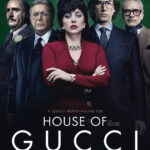Director
Todd Phillips
Starring
Joaquin Phoenix
Lady Gaga
Set after the events of Joker, Arthur Fleck [Phoenix] is incarcerated in Arkham State Hospital, awaiting trial. Outside, in the real world, the Joker persona has become legendary and has gained a cult following. En route to a meeting with his lawyer, Fleck bumps into a fellow patient, Harleen Quinzel [Gaga]. Over time the pair forge a bond and subsequently she is removed from the facility. With “Lee” in his life, Fleck stops taking his medication, starts to rile the guards and reverts to his former ways. We are then treated to his trial, where the Joker persona starts to fully takeover.
Let’s get something out of the way from the start: this movie is beautifully shot. There are several scenes and images that are so evocative and striking that you entirely forget the film has nothing of real substance to say. Much like 2019’s Joker, it is an exercise in imitation and elevation by bringing a sizeable budget to dedicated performances, rich production design, and gorgeously grim camera and lighting work. But it is also a significantly lesser beast. For all Joker’s flaws, it was telling a coherent and escalating story. Joker: Folie à Deux is set almost entirely in two locations and exists entirely in the shadow of its predecessor. Little more than a post mortem of a film we’ve already seen, trying to figure out if it should relish in its triumph or apologise and course correct. And as you cross the halfway point, a sense of reality dawns: this is the movie. The musical element isn’t going away, and the big climax or unfolding developments you may be hoping for are replaced with a limp court drama that retreads the events of the first film.
It cannot be understated how monumentally dull this sequel is. For a film billed as a Joker-centric musical co-starring Lady Gaga, we never witness the peak of possibility in that concept. Once again Phillips continues to riff off classics that did it better but there’s also an apologetic sense of shame that restricts the story from progressing or really going anywhere. In truth, it feels like the prison and trial should have just been the first act, and then the story gets properly underway. That’s the point where we start the story anew and find out what reality and the future is for Arthur post murder and Joker fame. What is the true, lasting impact in the wider world? Yet, thanks to a remarkably conflated sense of self importance, the movie almost aggressively states “We’re not telling more of this story, we’re going to clumsily dissect the last one and you’ll praise me for it!”
I will say, however, the initial transition to musical is actually pretty well handled. In fact, the film opens with a Tex Avery style cartoon called My Shadow & Me which does a reasonable job of quickly and succinctly illustrating the hold this alternate persona has over Fleck. But, unfortunately, even with its subtle introduction, the musical quickly outstays its welcome. And it’s hard to pinpoint why. Could it be the selection of crooning classics not gelling with the setting or audience? Or possibly the scenes themselves failing to be elevated by the presence of song? I believe it comes down to a lack of vision and ambition. It doesn’t do enough to really go over the top into bombastic theatrical musical. Instead, Joker: Folie à Deux whimpers through each track, semi-embarrassed by what it’s doing. But I will absolutely praise the sound mixing and Hildur Guðnadóttir’s score, which weaves in and out of each piece masterfully.
I also have to commend the cast. Despite having so little to actually work with, every single person turns up and delivers, trying to wring as much as they can out of this barely damp flannel. Brendan Gleeson is deceptively sinister, clearly a monstrous man but with a subtle heart that makes you want to like him, Steve Coogan is your typical smarmy reporter looking to get ratings, and Catherine Keener is the kind of lawyer you’d want to see on this case: one who is dedicated, passionate, and invested in getting this man the medical attention he needs. And that’s before we get to the co-leads. Yet again, these feel like iterations of established characters in name only but these new versions are interesting and captivating enough to draw you in. Fleck’s inner turmoil and torment continues to engage, and Phoenix once again goes above and beyond to throw himself into the performance. While Gaga illustrates that she can genuinely act and gives us an interesting take on a significantly amoral, manipulative but ultimately unknowable figure.
But that’s it. That’s all the positivity I can muster. At it’s core, this feels like a movie desperately struggling to hammer a concept into an ill-fitting housing. But no matter how hard it hammers away, the square peg simply will not fit into the round hole. So what we end up with is an uncomfortably lacklustre experience that insists on its own importance, while frantically trying to get to the finish line. It’s a film gifted another crack at the mic but has nothing to say because everything was left on the stage during the first performance. And when the final song started, I looked across the cinema and saw people with their heads in their hands, the sighs surpassing the speakers, as we were all collectively waiting for this thing to just end.
Ultimately, I don’t know who this film is supposed to be for. Detractors of the previous effort aren’t going to be swayed by whatever this is, and those turning up expecting another chapter in the bible of Fleck are going to feel betrayed. The whole thing feels like an out of control locomotive, unable to simply stop, charging inevitably towards collision and disaster. And while there have been some truly dire movies in the last few months alone (Borderlands, The Crow and Megalopolis to name a few), the only thing saving Joker: Folie à Deux from being a 1/5 is the genuinely impressive technical accomplishments. But going from cult acclaim, the accolade of being the highest R-rated box office, and winning several Oscars on a slim budget to this, is quite the comedown.
Release Date:
04 October 2024
The Scene To Look Out For:
Know the very worst kind of musical? A joyless musical. A reluctant musical that fights its potential and lacks determination to wow and amaze, muttering under its breath, “Don’t worry, this bit will be over soon.” Yet, there is one scene that comes close. During the court room scene (i.e. half of the movie), Fleck switches. Listening to the mounted defence, he finally snaps into the Joker persona, fires his lawyer, and proclaims he will represent himself; all while performing The Joker from The Roar Of The Greasepaint – The Smell Of The Crowd. Phoenix finally feels unleashed, the interspersed violence is shocking, the courtroom is transformed with heightened lighting and we feel like we’re getting a taste of what Joker holding court will actually look like. But then the film quickly reverts back to its mundane, methodical pacing and the promise of what could be falls away.
Notable Characters:
**significant spoilers within**
This movie ends in a way that will likely infuriate many. Having been returned to prison, likely facing the death penalty, and suffering the loss of his relationship with Lee, Arthur listlessly floats around Arkham. Only to be stopped by a fellow inmate, furious that Arthur would reject the Joker persona. As such, this new character tells a joke and stabs Arthur to death, before carving a smile into his own face. Personally, Fleck’s demise (no matter how it arrives) feels necessary for this story, but to tack on a bait and switch twist by saying the whole thing is in fact the origin of the real Joker (the one we’re all familiar with), just feels desperate. It’s the sort of first draft “wouldn’t it be really cool and clever” idea that, unless you workshop it from the start, feels undeserved and semi-insulting. Especially as this is an entirely new character who solely appears in this one scene.
Highlighted Quote:
“There is no joker, there’s just me.”
In A Few Words:
“An aggressively calamitous experiment that is simultaneously about nothing and for no one.”
Total Score: 2/5

![The Red Right Hand Movie Reviews [Matthew Stogdon]](https://reviews.theredrighthand.co.uk/wp-content/uploads/2021/12/cropped-header1.png)



